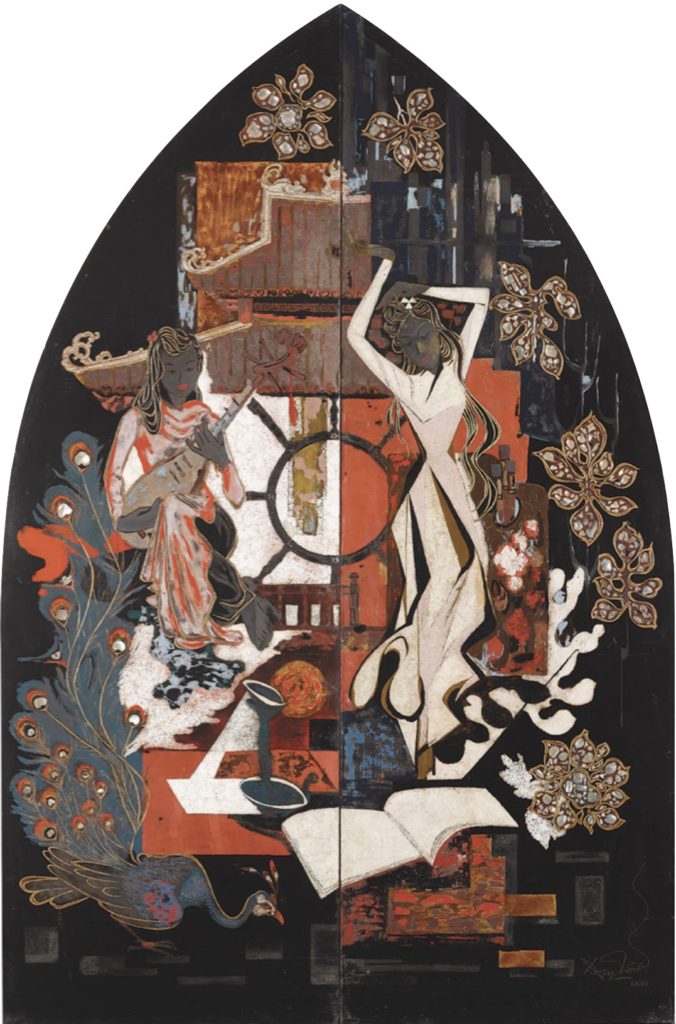Tran Dzu Hong – Scene from Truyen Kieu
An exceptional diptych lacquer work in terms of its theme, technique and narrative, Tran Dzu Hong needed two full years between 1961 and 1962 to complete the work after receiving a commission from the former Vietnamese president Ngo Dinh Diem.

In the 1950s, President Ngo, in a period of ultra-nationalism, decided to commission artworks from significant Vietnamese artists in order to decorate the national palaces and present works as honourable gifts to foreign dignitaries. This lacquer by Tran Dzu Hong was commissioned as part of this programme initiated by President Ngo, and completed before the president was assassinated in 1963.
The lacquer diptych was purchased by an American military personnel, and brought to the United States before being acquired by an overseas Vietnamese who recognized the historical significance of the lacquer.
The themes chosen for depiction in this lacquer lies at the heart of Vietnamese civilization: sitting in front of what is identifiable as the Temple of Literature built in 1070 are two girls who represent the two sisters in Tale of Kieu by Nguyen Du (1765-1820), Thuy Van and Thuy Kieu.
The narrative of Tale of Kieu is known to all Vietnamese: recounting the life, trials and tribulations of Thuy Kieu, a beautiful young woman who led a life of tragedy, demonstrating filial piety and sacrificing herself at many turns to save her family. She is finally reunited with her first love, Kim Trong at the end of the narrative, but had come round to that rather happier ending after leading a life of trial and tribulations. The other figure, Thuy Van, is her sister who fulfils her promise of marriage to her first love, Kim Trong, while she was unable to do so. The inspiration of Tale of Kiêu for this lacquer painting becomes clearer as we refer to the portion of the narrative where Kieu seems to play the lyre for Kim just after he said to her:
“Your renowned cithara is everywhere across the mounts the and the rivers, I hoped in vain to hear it.”
Yet elements of the lacquer exercise creativity. The treatment of Kieu’s face – particularly in the make-up she has on her lips and hair – differ from the Confucian teachings evident in Tale of Keu. The figure of Thuy Vu is dancing sensually, a marked departure from Nguyen Du’s work. The motifs found in the work are also mysterious: does the open book and the phoenix symbolize the measure of new knowledge and will the phoenix rise again?
And last but not least, the surface of the large lacquer is covered colorful and decorative patterns. The basic form of the diptych lacquer is cut in the shape of a lotus petal, a Buddhist symbol, is also a reminiscence of the mandorla for Cham divinities.
Tran Dzu Hong is celebrating a cultural heritage here: a heritage of thousand years of Buddhism in Vietnam and Confucianism and its female heroines.
In this monumental lacquer, the artist has perfected the technique of lacquer painting. As an art teacher at the Gia Dinh College of Fine Arts from 1958 to 1975, he knew how to apply his talent. The finish of his execution is not only perfect but he also demonstrated how to use all of the possibilities offered in lacquer painting in terms of the range of colours, diversity of multiple tones and the use of gold and egg shell.
Unique, stimulating and monumental, this lacquer by Tran Dzu Hong stands out as a major lacquer work in Vietnamese modern art.
Jean-François Hubert